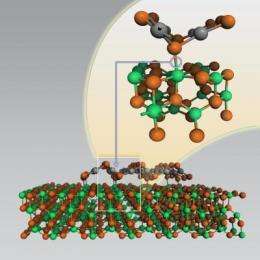Catalytic Catamarans: Common industrial catalyst sports rafts made of platinum

Catalysts convert useless or unwanted chemicals into useful or more desirable ones. Research in this week's Science reveals new, important details about a common catalyst: how rafts of chemically reactive platinum form in the catalyst. The new work yields insights into how to improve the industrial catalyst for oil refining, chemicals processing and environmental uses.
The study shows that aluminum atoms in the supporting material thirsty for another bond grab and anchor platinum. The anchors allow platinum atoms to group into rafts that float above the supporting surface, providing ample space for catalytic reactions.
Researchers in the Institute for Interfacial Catalysis at the Department of Energy's Pacific Northwest National Laboratory and at DOE's Oak Ridge National Laboratory performed the analysis of the industrial catalyst known as aluminum oxide-supported platinum. Such precious metal and oxide combinations are the most common kinds of industrial catalysts. The new work will help engineers control the preparation of the catalyst, which will lead to performance improvements.
"We've been able to specifically identify an important site for the anchoring of platinum on the aluminum oxide surface that's formed during synthesis," said PNNL chemist Chuck Peden and coauthor of the study. "Although platinum rafts have been observed before, this is the first time we've had a clear molecular-level view of the processes that create them."
Supporting Role
In these catalysts, the oxides are merely a surface on which the precious metals sit while the metals break and form bonds in other molecules, such as those found in automobile exhaust. The most efficient catalysts spread the precious metals evenly over the surface of the oxide. Inefficient ones have precious metal atoms balled up in clumps, with the interior atoms unavailable to do their job on incoming molecules.
Chemists working with gamma-aluminum oxide supports and platinum metal knew that under some conditions, rafts of platinum atoms could form on the oxide surface. Unlike balls of atoms, rafts present most of their resident atoms to incoming molecules, making them desirable structures. But to control production of the rafts, the team had to learn how they formed.
To find out, the team used powerful instruments at EMSL, DOE's Environmental Molecular Sciences Laboratory on the PNNL campus, and the High Temperature Materials Laboratory at ORNL. The team prepared gamma-aluminum oxide under typical catalyst synthesis conditions and examined the supporting material before and after adding platinum.
Fabulous Five
First, they examined the chemical nature of the support at EMSL, which houses one of the world's largest instruments of its kind -- a 900-megahertz nuclear magnetic resonance (NMR) spectrometer. The NMR provided unprecedented resolution of the aluminum oxide support, which allowed the team to identify aluminum atoms with certain properties. By their chemical nature, aluminum atoms prefer to be bound to either four or six atoms. The team found, in the absence of platinum, that some were bound to an uncomfortable five.
Adding platinum to the mix, however, caused the number of aluminum atoms with five bonds to decrease, and the number of atoms with six bonds to increase. The number of four-bonded atoms stayed constant, suggesting that platinum atoms anchor at sites with come-hither, five-bonded aluminum atoms, so-called penta sites.
The team found they could increase the number of penta sites by raising the temperature during catalyst synthesis. More penta sites meant more platinum atoms bound to the support.
Having found anchor points, the team zoomed in with the JEOL 2200FS aberration-corrected microscope, which could discern individual platinum atoms, at HTML. At low concentrations of the metal, individual platinum atoms showed up as bright spots scattered across the dark surface. At higher concentrations, the telltale image of platinum rafts could be seen above the aluminum oxide.
Penta Pontoons
Lastly, the team showed that penta-aluminum atoms were needed for the rafts to form. Alpha-aluminum oxide does not contain penta sites. When the researchers looked under the microscope at catalyst material formed with alpha-aluminum oxide, platinum atoms formed balls that tottered around on the surface instead of tidy rafts.
Theoretical analysis that took into account all the experimental data yielded a model of how the catalyst material forms. The results provide insight into how they could produce a better performing catalyst.
"This understanding we've gained suggests some additional tricks one could play to get better dispersion of the platinum atoms," said Peden. "For example, if we can find conditions at which we can add the platinum at higher temperature on a larger scale than this experiment, then we would have more anchoring sites available."
Finding the conditions that will allow the chemists to control the number and distribution of penta sites will be the subject of future research.
More information: Ja Hun Kwak, Jianzhi Hu, Donghai Mei, Cheol-Woo Yi, Do Heui Kim, Charles H.F. Peden, Lawrence F. Allard and Janos Szanyi, Co-ordinatively unsaturated Al3+ centers as binding sites for active catalyst phases on γ-Al2O3, Science, DOI 10.1126/science.1176745
Source: Pacific Northwest National Laboratory (news : web)



















